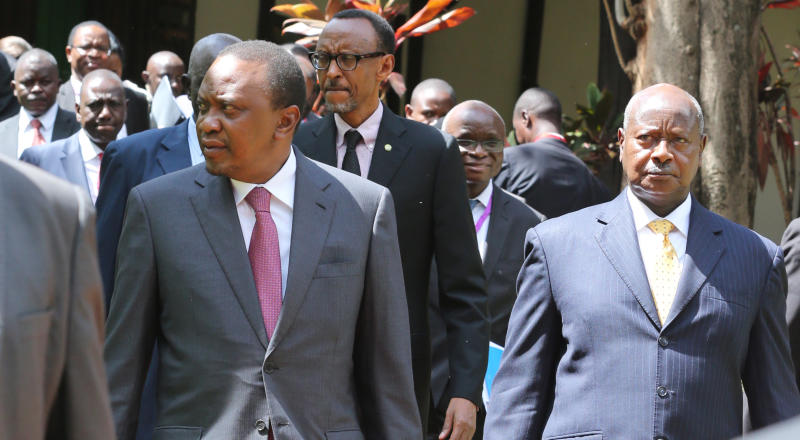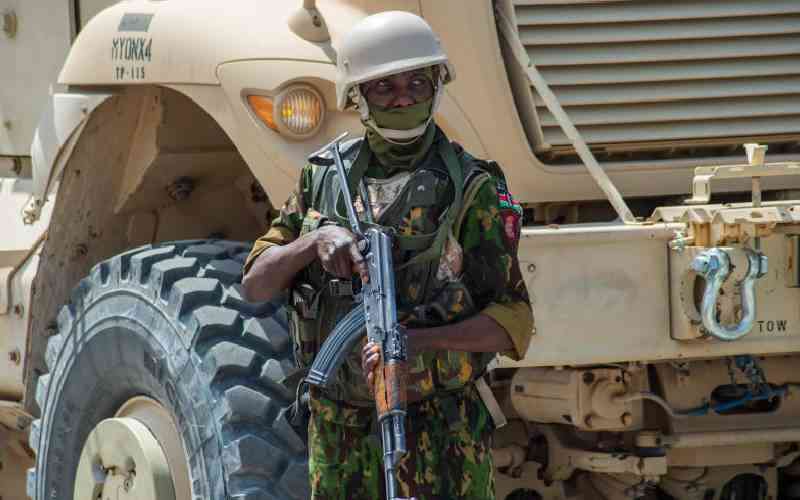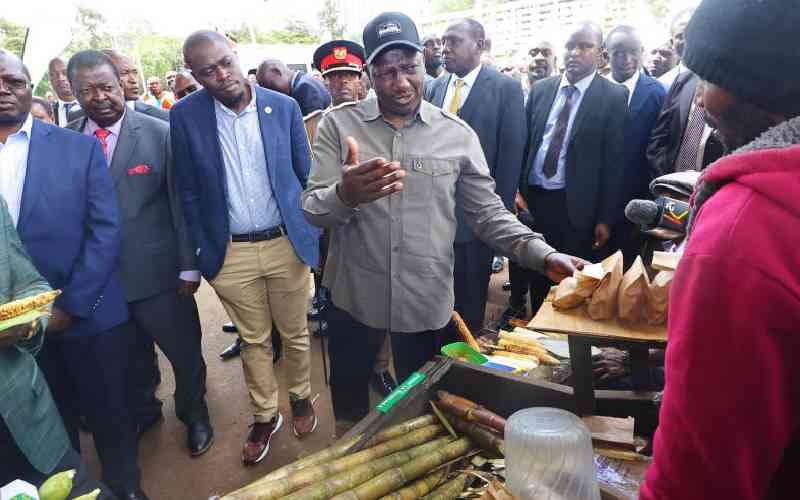
Regional realignments and long-running disputes are now threatening to derail President Uhuru Kenyatta’s legacy projects, among them the Sh1 trillion Standard Gauge Railway (SGR) investment.
Key among them is a historical miscalculation that risks rendering Kenya landlocked.
This is if a maritime area of about 255,000km, which was determined through the parallel of latitudes in 1979, is invoked by the Somali government that is fighting Kenya over oil blocks in the Indian Ocean.
Kenya says its border extends to the Indian Ocean on a straight line from its border with Somalia as well as a mutual agreement with Tanzania on maritime boundary which closes as a straight line along Pemba Island.
If Somalia’s claim is affirmed by the Hague-based International Court of Justice (ICJ), then its boundary will join that of Tanzania, locking out East Africa’s biggest economy in a triangle.
And Kenya won’t hear any of this. Speaking on Friday at a British think tank Royal United Services Institute, Cabinet Secretary Foreign Affairs Amb Monica Juma warned Kenya will not cede any territory or negotiate about it.
“From where we are sitting as Kenya, the bottom line is that we will not be available to negotiate territorial integrity of Kenya and that all necessary measures to adhere to a sworn constitutional imperative and duty to protect the territorial integrity and the sovereignty of Kenya will be deployed,” said Amb Juma.
She claimed the delicate matter had been turned into internal politics, making it difficult to handle it diplomatically.
“Unfortunately, this matter has become a domestic political issue in Somalia. In fact, it has been roped into the electioneering mantra and I think this has become a difficult thing when a matter such as this becomes the defining mantra for those that are seeking re-election,” said Juma. The CS claimed that the matter was a commercial issue where Western firms wanted to take advantage of the fragile situation to extract resources from the continent.
She warned that the standoff could escalate tensions in the already fragile region, leading to large-scale displacement, collapse of states, international crimes, piracy, drugs, terrorism and ecological fragility, creating drought and famine and environmental degradation.
“We believe this situation has been precipitated by commercial interests, particularly western interests and we hope we would not run into the situation we have seen. I think there are people who would rather cut deals with a government that does not have the legal and policy frameworks to conclude contract as we understand them,” said Juma.
Already, Exxon Mobil and Shell have expressed interest to return to Somalia. Kenya knows that this push for a few blocks of oil have serious ramifications on its strategic location. Losing access to the Indian Ocean would put Kenya’s investments in the Northern Corridor in doubt even as a tussle in the hinterland between Rwanda and Uganda puts the viability of having the rail cut through East Africa in doubt.
The coalition of the willing may as well be dead as regional fights and supremacy wars that have characterised the Great Lakes region rise - this time pitting Uganda’s President Yoweri Museveni and Paul Kagame of Rwanda. The two leaders have fallen out due to personal and complex historical dynamics.
Rwanda has protested the arrest and detention of its citizens without trial by Uganda, whom Kampala accuses of espionage. Uganda’s confrontation with Rwanda is just one of the many disputes pitting almost each regional State against the other.
Stay informed. Subscribe to our newsletter
Rwanda does not seeing eye to eye with Burundi and the Democratic Republic of Congo over rebel groups that Kigali considers destabilising forces.
Rwanda has particularly accused Burundian President Pierre Nkurunziza’s administration of sympathising with the rebels. Kenya, for its part, has had a long-running spat with Tanzania on trade. The rivalry has seen the two countries violate commonly agreed tariffs to block each other’s goods.
The Kenya-Uganda tiff over Migingo is also yet to be resolved.
Ethiopia, on the other hand, is dealing with an internal revolt in the Amhara region whose President Ambachew Mekonnen and two other officials were killed in Bahir Dar. This is even as relations with its age-old foe, Somalia remain frosty, especially after a map on the Ethiopian Foreign Ministry’s website appeared to have annexed Somalia.
“We sincerely regret any confusion and misunderstanding this incident might have caused,” said the ministry in a statement.
The squabbles in the Horn of Africa have so far been restricted to shuttle diplomacy, but with Rwanda and Uganda toying with the idea of deploying forces and Kenya’s half-hearted engagement with the ICJ as it pushes for an out-of-court settlement, there is no telling how thing will end.
“The Red Sea has experienced a competition for port, military hubs, and militarisation of external actors. In fact, the Red Sea and the Gulf of Aden have witnessed perhaps the largest number of militarily fleet and foreign footprint anywhere in its history. On the ground, the rivalry and posturing is generating huge political threats,” said Amb Juma.
At the height of the dispute between Kigali and Kampala, President Uhuru Kenyatta travelled to Rwanda on a two-day working visit where he met President Paul Kagame who had just held private talks with Tanzania’s John Magufuli and South Africa’s Cyril Ramaphosa over the rift.
Uganda’s Museveni, on the other hand, visited Kenya in March with the trip seen as part of the wider negotiations to settle the tiff with Rwanda.
“Kenya should be careful because we have more to lose if the situation escalates because we need both of them,” said an economist who declined to be named. Analysts warn that if the Rwanda-Uganda conflict is not sorted out soon, and with Kenya being seen to be taking sides, it risks losing both markets that heavily rely on the Mombasa port for their imports.
When Rwanda closed its border with Uganda at Katuna, it detained goods, including perishable foodstuffs from Kenya as well as fuel headed to Burundi, leaving transporters counting huge losses.
Kenya is in a tight fix in trying to arbitrate the dispute, with some claiming it is supporting Uganda since it’s its biggest trading partner. President Museveni has leverage in the matter since he holds sway in giving the SGR a lifeline by committing to the extension of the line to Malaba and then Kampala for it to be commercially viable.
White elephants
Uganda’s input is also key in the construction of an oil pipeline that can guarantee Lamu Port and Lamu-Southern Sudan-Ethiopia Transport Corridor (Lappset) viability, without which Kenya’s investments in the two projects could turn to be white elephants.
However, director of Petroleum Focus Consultants George Wachira says it would be difficult to get the pipeline given the advanced negotiations with Tanzania. “Uganda is committed to the Tanzanian route, what they have not agreed on are the tariffs, so that one is gone, we have also advanced with our plans,” Mr Wachira said.
According to Control Risk, a global risk management firm, rivalry in East Africa and poor upstream markets to supply enough business to pay off on mega projects, may lead to underutilised ports, idle rail, and empty pipelines.
The firm says many African countries are competing to become the next ‘Dubai-Singapore’ hub of the continent which may make their copycat mega project unviable. “Regional rivalries increase the risk of over-supply,” Control Risks says.
“These could prove economically unviable and even impose an excessive burden on public finances, raising longer-term sovereign risks,” the report warned.
Uganda’s dalliance with Tanzania to build an oil pipeline may have left key projects unviable.
 The Standard Group Plc is a
multi-media organization with investments in media platforms spanning newspaper
print operations, television, radio broadcasting, digital and online services. The
Standard Group is recognized as a leading multi-media house in Kenya with a key
influence in matters of national and international interest.
The Standard Group Plc is a
multi-media organization with investments in media platforms spanning newspaper
print operations, television, radio broadcasting, digital and online services. The
Standard Group is recognized as a leading multi-media house in Kenya with a key
influence in matters of national and international interest.
 The Standard Group Plc is a
multi-media organization with investments in media platforms spanning newspaper
print operations, television, radio broadcasting, digital and online services. The
Standard Group is recognized as a leading multi-media house in Kenya with a key
influence in matters of national and international interest.
The Standard Group Plc is a
multi-media organization with investments in media platforms spanning newspaper
print operations, television, radio broadcasting, digital and online services. The
Standard Group is recognized as a leading multi-media house in Kenya with a key
influence in matters of national and international interest.








